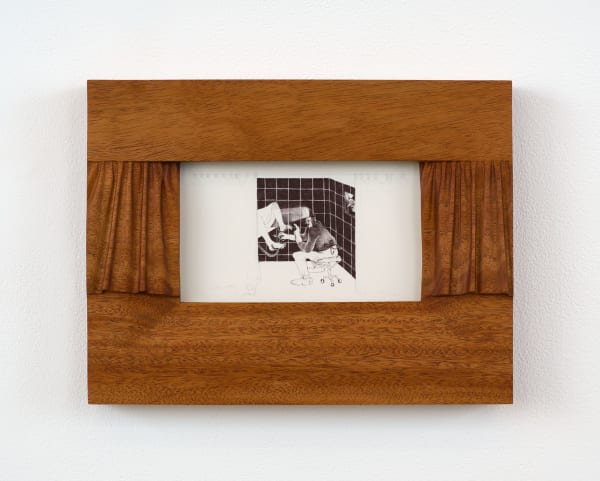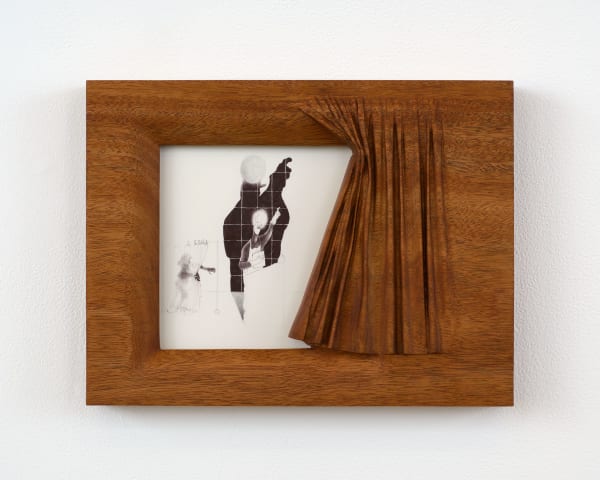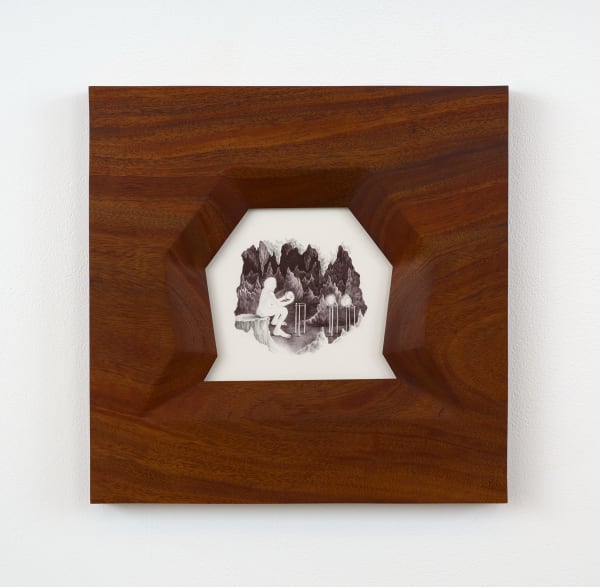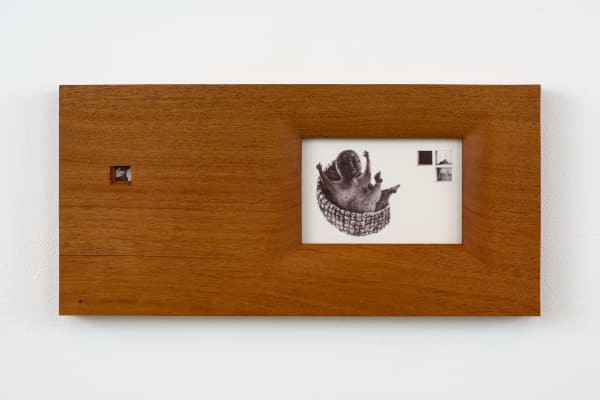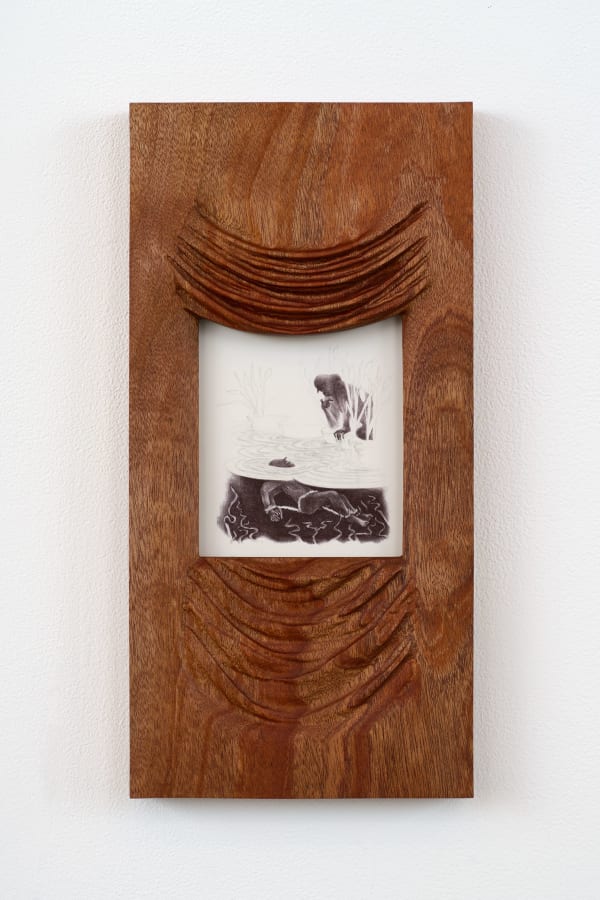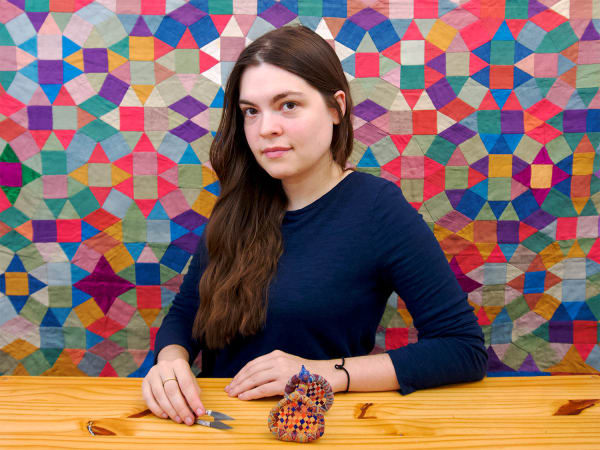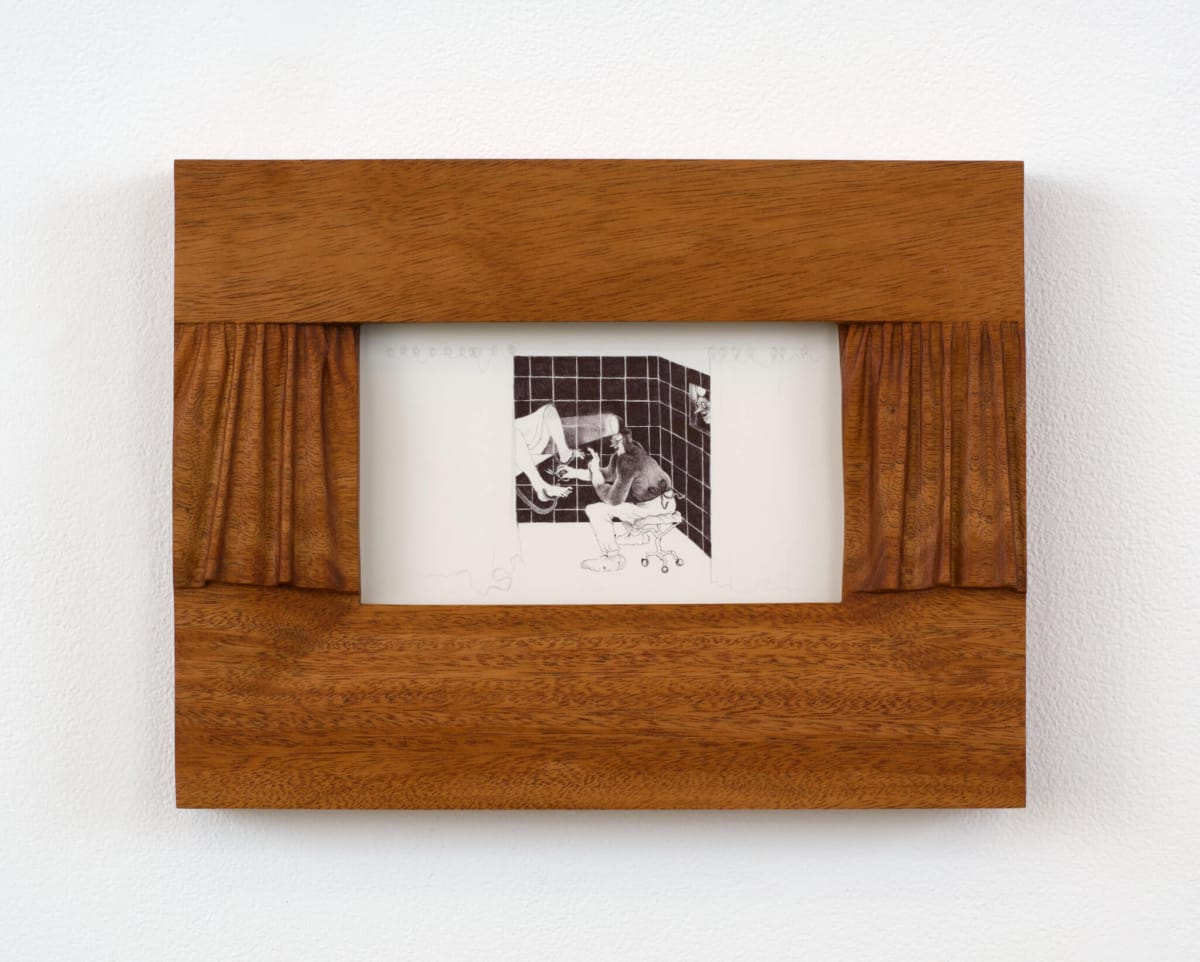Em Kettner: Homebound
François Ghebaly is proud to present Homebound, American multimedia artist Em Kettner’s first exhibition at the gallery’s New York space. In Homebound, Kettner offers the latest iteration in her practice’s core consideration of life and disability. Across fifteen drawn miniatures in intricately crafted artist’s frames, Kettner reflects on kinship, autonomy, and medicalism with utmost care and the occasional dose of levity.
Kettner’s new series of drawings in sculpted wooden frames expands upon the artist’s established practice of depicting the disabled body in contexts where care exceeds a definition of sentimental help and becomes an ethos integral to the formation of community. Disability is the integral aspect from which flows bondedness in iterations erotic, emotional, intellectual, and amorous. What sets the series apart from Kettner’s previous work is its unwavering examination of conditions where the misapplication of care becomes an alibi for violation.
The series’s title makes her strategy plain; it describes someone confined to their home due to having an illness or disability in our inaccessibly built world, and it describes the act of seeking a home or community by pushing through those imposed confines. Similarly, the act of examining, so important to Kettner’s critical pursuit, cannot be dissociated from the physical examination process central to modern medical procedure, the source of the series’s sole rigid motif: fear.
In The Echo Chamber (2024), all themes converge in a scene of surgical abuse. Indeed, the viewer is compelled to sympathize with the patient who will soon feel the snip of the doctor’s scissors, but so much invasive looking demands one question where one’s allegiance lies and whose authority one relies on in the final analysis: the caregiver’s or the cared for? To what extent does the expert opinion become the default conclusion?
The Echo Chamber also speaks to the origins of Homebound, which began, in part, as the foundation for an interactive digital project entitled Doctor, Doctor, produced and published by Fulcrum Arts in 2023. A discrete project, Homebound continues the narrative Kettner set forth in Doctor, Doctor, which traces a history of the perception of disabled bodies, from Iron Age bogs in Northern Europe to present day California, all while interweaving elements from mythology and the artist’s own experiences living with disability. Kettner links superstition and sacrificial rite to 21st-century medical practice, which have served to stigmatize and marginalize the non-normative “other” from the moment of conception. In her retelling, the disabled person—an abandoned or abused child in many cases—is repositioned from history’s narrative hinterland to its heroic center.
The visual encounter of Homebound is supple; it does not prescribe a single approach. Viewers can peek behind curtains and through peepholes rendered in ink and graphite and carved into the drawings’ wooden frames, connecting chambers and constructing narrative spaces of their own mental design. The Second Act (2024) emphasizes this layered storytelling mode. We are positioned as though seated in a theater, or by a fire and in a safe place, thanks to the warm wood abutting the cold clinic. And the warm wood against the wet rock of Hephaestus in the Hollow (2024) allows us to gaze with self-aware comfort upon the Greek god of forges, in turn gazing upon the automatons that do his bidding, as his physical condition prevents him from quitting his cave.
The most instructive image for engaging the logic of Homebound, however, is The Next Born (2024), which opens a view onto a room almost defiant to the laws of physical space. Each opening in its walls is occupied by a figure, allegorical in tone if not by definition—patient, doctor, child, and an unknown someone who stands, perhaps, on the threshold of the future and the past. The drawing’s recombinational action exemplifies the turning/overturning methodology Kettner embraces. She demonstrates how and what we see and know is often only a fragment, occluded by environments built according to ideologies that assume totality. Such absoluteness, Kettner shows, is simply not the case, and so in making malleability an ethos all its own, she likewise makes Homebound an act of radical care.
Em Kettner (b. 1988, Philadelphia, PA) is an artist and writer based in Richmond, CA. Recent solo exhibitions include Chapter, New York (2022); François Ghebaly, Los Angeles (2022, 2021); Specialist, Seattle (2022); Goldfinch, Chicago (2020); and Harpy, Rutherford (2018). Kettner’s work has been reviewed and published in ArtForum, Art in America, Sculpture Magazine, Contemporary Art Review LA (CARLA), HyperAllergic, Sixty Inches From Center, Institutional Model, and Fulcrum Arts: Sequencing. She is the recipient of the Wynn Newhouse Award, the MIUSA Women’s Institute on Leadership and Disability, and an SAIC Teaching Fellowship. Kettner earned her BFA from the University of the Arts in Philadelphia, and an MFA from the School of the Art Institute of Chicago. Homebound is her third exhibition with François Ghebaly.
-
 Em Kettner, Doctor, Doctor, 2024
Em Kettner, Doctor, Doctor, 2024 -
 Em Kettner, The Watchman, 2024
Em Kettner, The Watchman, 2024 -
 Em Kettner, The Echo Chamber, 2024
Em Kettner, The Echo Chamber, 2024 -
 Em Kettner, The Spectre + The Brotherhood, 2024
Em Kettner, The Spectre + The Brotherhood, 2024 -
 Em Kettner, The Master of Ceremonies, 2024
Em Kettner, The Master of Ceremonies, 2024 -
 Em Kettner, The Gatekeeper, 2024
Em Kettner, The Gatekeeper, 2024 -
 Em Kettner, Exam Room Stool / The Doctor is Out, 2024
Em Kettner, Exam Room Stool / The Doctor is Out, 2024 -
 Em Kettner, The Second Act, 2024
Em Kettner, The Second Act, 2024 -
 Em Kettner, The Foundling in the Old Growth, 2024
Em Kettner, The Foundling in the Old Growth, 2024 -
 Em Kettner, Hephaestus in the Hollow, 2024
Em Kettner, Hephaestus in the Hollow, 2024 -
 Em Kettner, The Changeling + The Curious Neighbors, 2024
Em Kettner, The Changeling + The Curious Neighbors, 2024 -
 Em Kettner, The Next Born, 2024
Em Kettner, The Next Born, 2024 -
 Em Kettner, Rear Window, 2024
Em Kettner, Rear Window, 2024 -
 Em Kettner, The Peat Bog + The Problem Child, 2024
Em Kettner, The Peat Bog + The Problem Child, 2024 -
 Em Kettner, Home Birth, 2024
Em Kettner, Home Birth, 2024 -
 Em Kettner, More Room, 2024
Em Kettner, More Room, 2024




